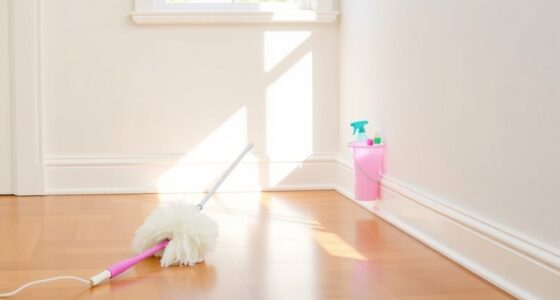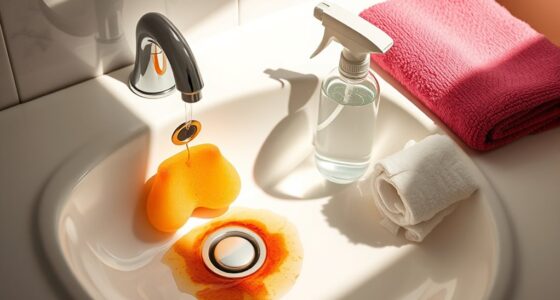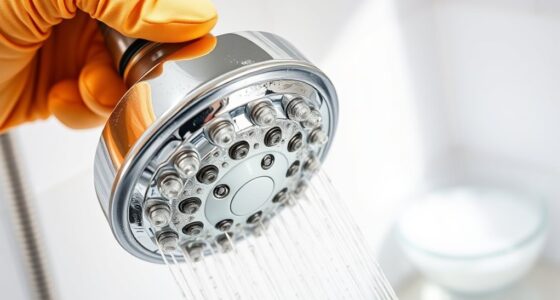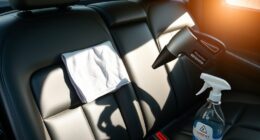To clean kids’ toys safely, start by checking each toy’s care instructions and material type. Wash soft toys in warm water with gentle, non-toxic detergent or spot clean with mild soap, and disinfect plastic toys using a vinegar solution for safe sanitation. Use disinfectant wipes labeled as non-toxic for surfaces, and always rinse or air dry toys thoroughly. Store toys in a clean space and regularly sanitize to maintain hygiene—keep going to learn more effective cleaning tips.
Key Takeaways
- Check toy labels to determine if they are machine washable or require spot cleaning.
- Use warm water and non-toxic, child-safe detergent for washing soft toys or spot cleaning surfaces.
- Disinfect plastic and rubber toys with a vinegar-water solution, allowing them to sit before wiping and rinsing.
- Choose commercial disinfectant wipes labeled as non-toxic and kid-safe for quick and effective cleaning.
- Store toys in a clean, dry environment and sanitize regularly to prevent bacteria and mold buildup.

Are you wondering how to keep your kids’ toys clean and safe? It’s a common concern, especially since little ones tend to put toys in their mouths or chew on them. The key is using effective sanitizing methods combined with non toxic cleaning techniques. You want to eliminate germs without exposing your children to harsh chemicals that could cause irritation or allergic reactions. Luckily, there are simple, safe ways to do this.
Start by inspecting each toy to determine if it’s suitable for washing. Plush toys, plastic items, and rubber figures are usually easy to clean. For soft toys, check the label for care instructions. Many plush toys can be washed in your washing machine using warm water and a gentle, non toxic detergent. If the toy isn’t machine washable, you can spot clean it with a mixture of water and a few drops of mild, non toxic soap. Use a clean cloth to wipe down the surface, then rinse with a damp cloth to remove soap residue. This approach ensures you’re using non toxic cleaning methods that are safe for your child.
Inspect toys and wash soft ones in a gentle, non toxic detergent.
For plastic toys, a thorough cleaning involves disinfecting with safe sanitizing methods. You can create an effective solution by mixing equal parts of water and white vinegar, which acts as a natural disinfectant. Spray or wipe down the toys with this mixture, making sure to cover all surfaces. Vinegar is non toxic and free from harsh chemicals, making it ideal for sanitizing toys. After applying, let the toys sit for a few minutes before wiping them clean with a damp cloth. For extra safety, you can rinse plastic toys with hot water after disinfecting, then let them air dry completely. Incorporating automation in cleaning can help streamline this process and ensure thorough sanitation.
If you prefer a quicker method, commercial disinfectant wipes labeled as non toxic and kid-safe are a convenient option. Always read the label to ensure they’re free from harmful chemicals. Wipe down all toy surfaces thoroughly, paying attention to crevices and hard-to-reach areas. Afterward, let the toys air dry or wipe them with a clean towel. Remember, regular cleaning helps prevent the buildup of bacteria and keeps your child’s play area hygienic.
Finally, always store toys in a clean, dry place to prevent dirt and mold. Regularly washing and sanitizing your kids’ toys using safe, non toxic cleaning and sanitizing methods will give you peace of mind that your little one’s playthings are both fun and safe. This simple routine helps protect their health while encouraging good hygiene habits from a young age.
Frequently Asked Questions
Are Natural Cleaning Products Safe for Children’s Toys?
Yes, natural cleaning products are generally safe for children’s toys. They help reduce chemical residues and lessen environmental impact, making them a healthier choice. You can confidently use ingredients like vinegar, baking soda, or mild soap to clean toys, knowing you’re minimizing exposure to harsh chemicals. Always rinse thoroughly and check toy labels to guarantee they’re compatible with natural cleaners, ensuring safe and effective cleaning for your kids.
How Often Should I Disinfect Plush Toys?
You should sanitize plush toys at least once a month to keep them safe and clean. Regular cleaning frequency depends on how often your kids play with them and their toy storage habits. For toys that get heavy use or are stored in less clean environments, disinfect more often. Use gentle, natural cleaning products and make sure toys are thoroughly dried before returning them to toy storage, preventing bacteria growth.
Can I Use Bleach on Plastic Toys?
Sure, go ahead and dunk your plastic toys in bleach—what’s the worst that could happen? Just kidding! Bleach isn’t recommended because of toxic chemical concerns and material compatibility issues. Instead, opt for safer options like soap and water or diluted vinegar solutions. Your kids’ toys can stay clean without exposing your little ones to harmful chemicals, ensuring safe play and peace of mind.
What’s the Safest Way to Clean Electronic Toys?
To clean electronic toys safely, you should use a soft cloth slightly dampened with water and a mild soap. Avoid harsh chemicals that could damage the toy material or harm your child. Clean these toys regularly, ideally once a week, to prevent germs. Make sure to unplug and remove batteries before cleaning, and never immerse electronic toys in water. This routine keeps them safe, clean, and functioning well.
Are Dishwasher Cycles Effective for Sanitizing Toys?
Dishwasher cycles, especially sanitizing cycles, can be effective for cleaning toys, but it depends on the toy material. You should check if the toys are dishwasher-safe to avoid damage. Sanitizing cycles use high heat and water pressure, which help eliminate bacteria and germs. However, for delicate or non-dishwasher-safe toys, hand washing or other cleaning methods might be safer. Always follow manufacturer instructions to guarantee proper cleaning.
Conclusion
Now that you know how to clean your kids’ toys safely, it’s almost like a coincidence that keeping them germ-free also keeps your home healthier. By regularly disinfecting and choosing gentle cleaning methods, you’re not only protecting your little one but also creating a cleaner environment for everyone. It’s funny how a simple routine can have such a big impact—sometimes, the smallest habits make the biggest difference in your family’s well-being.










